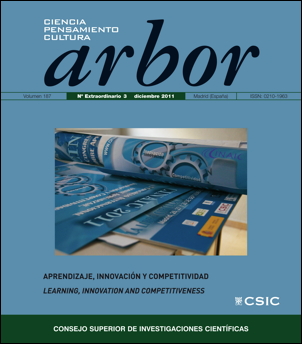Differences in the levels of motivation according to gender and type of school in the strategic learning of a foreign language
DOI:
https://doi.org/10.3989/arbor.2011.Extra-3n3149Keywords:
Motivation, learning, foreign language, adolescentsAbstract
This research shows an analysis of the main motivational models applied to foreign language acquisition and is aimed at identifying the motivational variables that present the highest influence in the strategic acquisition of a foreign language. The questionnaire Autoeficacia y Motivación Académica was given to a sample of 564 subjects (309 males and 254 females) who were studying 3rd (41.030%) and 4th (28.597%) of Secondary Education and 1st year of High School (30.373%) in two schools of the Comunidad de Madrid (41.7% in a public school and 58.3% in a private school). Results show that values of items related to instrumental motivation are the highest. Females obtained higher results in all factors studied in the same way as the private school with the exception of the variable Perceived Ability which was higher in the public school.
Downloads
References
Csizer, K. y Lukacs, G. (2010): “The comparative analysis of motivation, attitudes and selves: The case of English and German in Hungary”, System, vol. 38, 1, pp. 1-13. http://dx.doi.org/10.1016/j.system.2009.12.001
Deci, E. L. y Moller, A. C. (eds.) (2005): The concept of competence: A starting place for understanding intrinsic motivation and self-determined extrinsic motivation, New York, Guilford Publications.
Dörnyei, Z. (1994): “Motivation and motivating in the foreign language classroom”, The Modern Language Journal, vol. 78, 3, pp. 273-284.
Dornyei, Z. (2005): The psychology of the language learner: Individual differences in second language acquisition, Mahwah, New Jersey, Lawrence Erlbaum.
Elliot, A. J. y Dweck, C. S. (2005): Handbook of competence and motivation, Nueva York, Guilford Publications.
Gardner, R. C. y Tremblay, P. F. (1994): “On motivation, research agendas, and theoretical frameworks”, Modern Language Journal, vol. 78, pp. 359-68.
Hernandez, T. (2006): “Integrative motivation as a predictor of success in the intermediate foreign language classroom”, Foreign Language Annals, vol. 39, 4, pp. 605-617. http://dx.doi.org/10.1111/j.1944-9720.2006.tb02279.x
Inbar, O.; Donitsa-Schmidt, S. y Shohamy, E. (2001): “Students’ motivation as a function of language learning: the teaching of Arabic in Israel”, en Z. Dörnyei y R. Schmidt (eds.), Motivation and second language acquisition, Honolulu, University of Hawai“i, Second Language Teaching and Curriculum Center, pp. 76-93.
Kimura, Y.; Nakata, Y. y Okumura, T. (2001): “Language learning motivation of EF Llearners in Japan-a crosssectional analysis of various learning milieus”, JALT Journal, vol. 23, 1, pp. 47-68.
Morena Taboada, M.; Sánchez Burón, A. y Fernández Martín, M. P. (2011): “Diferencias por sexo y curso en el aprendizaje estratégico de la lengua extranjera”, en J. M. Román (comp.), Educación, Aprendizaje y Desarrollo, Madrid, APP, pp. 6113-6127.
Oxford, R. L. y Shearin, J. (1996): “Language learning motivation in a new key”, en R. L. Oxford (ed.), Language Learning Motivation, Pathways to the New Century, Honolulu, University of Hawaii Press, pp. 121-144.
Perry, N.; Turner, J. C. y Meyer, D. K. (2006): “Student Engagement in the classroom”, en P. Alexander y P. Winne (eds.), Handbook of Educational Psychology, Mahwah, NJ, Erlbaum, pp. 327-348.
Wijnia, L.; Loynes, S. M. M. y Derous, E. (2011): “Investigating effects of problem- based versus lecture-based learning environments on student motivation”, Contemporary Educational Psychology, vol. 36, 2, pp. 101-113. http://dx.doi.org/10.1016/j.cedpsych.2010.11.003
Zimmerman, B. J. (2000): “Self-efficacy: an essential motive to learn”, Contemporary Educational Psychology, vol. 25, 1, pp. 82-91. http://dx.doi.org/10.1006/ceps.1999.1016 PMid:10620383
Zimmerman, B. J. (2008): “nvestigation selfregulation and motivation: historical background, methodological developments, and future prospects”, American Educational Research Journal, vol. 45, 1, pp. 166-183. http://dx.doi.org/10.3102/0002831207312909
Zimmerman, B. J. y Schunk, A. (2008): “Motivation: An essential dimension of selfregulated learning”, en D. H. Schunk y B. J. Zimmerman (eds.), Motivation and selfregulated learning: Theory, research, and applications, New York, Erlbaum, pp. 1-30.
Zimmerman, J.; Bandura, A. y Martínez- Pons, M. (1992): “Self-motivation for academic attainment: the role of selfefficacy beliefs and personal goal setting”, American Educational Research Journal, vol. 29, pp. 663-676.
Downloads
Published
How to Cite
Issue
Section
License
Copyright (c) 2011 Consejo Superior de Investigaciones Científicas (CSIC)

This work is licensed under a Creative Commons Attribution 4.0 International License.
© CSIC. Manuscripts published in both the printed and online versions of this Journal are the property of Consejo Superior de Investigaciones Científicas, and quoting this source is a requirement for any partial or full reproduction.
All contents of this electronic edition, except where otherwise noted, are distributed under a “Creative Commons Attribution 4.0 International” (CC BY 4.0) License. You may read the basic information and the legal text of the license. The indication of the CC BY 4.0 License must be expressly stated in this way when necessary.
Self-archiving in repositories, personal webpages or similar, of any version other than the published by the Editor, is not allowed.














